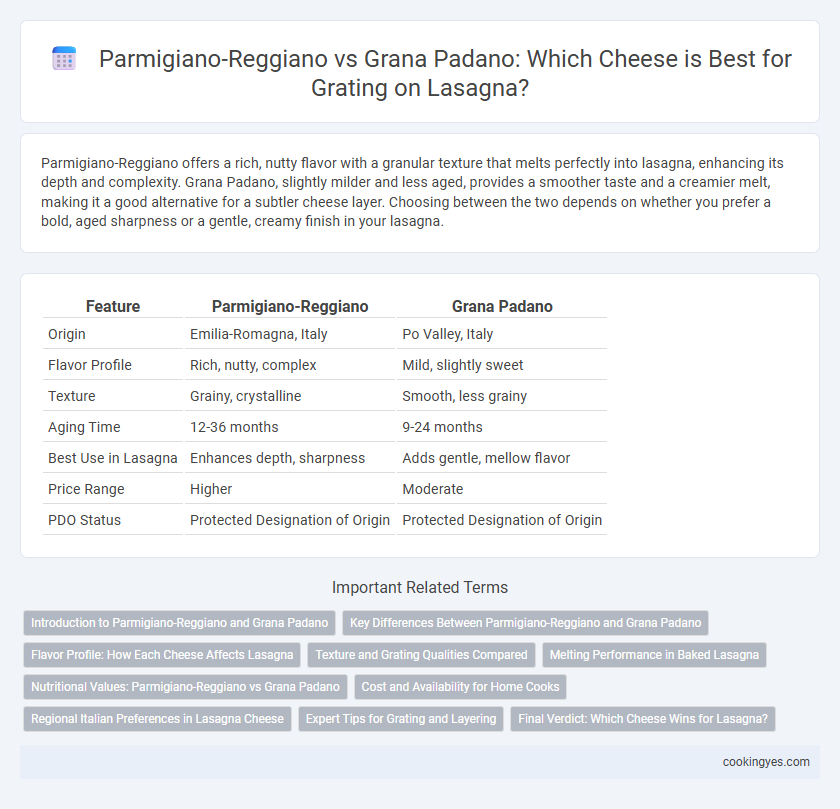Parmigiano-Reggiano offers a rich, nutty flavor with a granular texture that melts perfectly into lasagna, enhancing its depth and complexity. Grana Padano, slightly milder and less aged, provides a smoother taste and a creamier melt, making it a good alternative for a subtler cheese layer. Choosing between the two depends on whether you prefer a bold, aged sharpness or a gentle, creamy finish in your lasagna.
Table of Comparison
| Feature | Parmigiano-Reggiano | Grana Padano |
|---|---|---|
| Origin | Emilia-Romagna, Italy | Po Valley, Italy |
| Flavor Profile | Rich, nutty, complex | Mild, slightly sweet |
| Texture | Grainy, crystalline | Smooth, less grainy |
| Aging Time | 12-36 months | 9-24 months |
| Best Use in Lasagna | Enhances depth, sharpness | Adds gentle, mellow flavor |
| Price Range | Higher | Moderate |
| PDO Status | Protected Designation of Origin | Protected Designation of Origin |
Introduction to Parmigiano-Reggiano and Grana Padano
Parmigiano-Reggiano and Grana Padano are two renowned Italian hard cheeses commonly used for grating over lasagna, each offering distinct flavors and textures. Parmigiano-Reggiano, with its Protected Designation of Origin (PDO) status, is aged a minimum of 12 months, offering a complex, nutty taste ideal for elevating classic Italian dishes. Grana Padano, also PDO-certified, has a milder, creamier profile and a shorter aging period of 9 to 24 months, providing a versatile option for lasagna toppings and fillings.
Key Differences Between Parmigiano-Reggiano and Grana Padano
Parmigiano-Reggiano offers a more complex, nutty flavor with a granular texture ideal for topping lasagna, while Grana Padano presents a milder, less salty taste with a creamier consistency. Parmigiano-Reggiano is aged longer, typically 12 to 36 months, enhancing its depth and crystal formation, whereas Grana Padano ages between 9 to 20 months, resulting in a subtler profile. The strict production regulations and geographical origin of Parmigiano-Reggiano also contribute to its distinctive richness compared to the more widely produced Grana Padano.
Flavor Profile: How Each Cheese Affects Lasagna
Parmigiano-Reggiano offers a complex, nutty, and slightly fruity flavor that intensifies the richness of lasagna, creating a savory depth with its crystalline texture that melts evenly. Grana Padano provides a milder, creamier taste with subtle grassy undertones, contributing a smoother, less sharp finish, ideal for balancing robust tomato sauces. Choosing Parmigiano-Reggiano elevates lasagna with bold umami notes, while Grana Padano enhances it through a gentle, harmonious cheese presence.
Texture and Grating Qualities Compared
Parmigiano-Reggiano offers a granular, crumbly texture that grates into fine, fluffy shreds ideal for melting evenly over lasagna layers. Grana Padano features a slightly softer texture with a more consistent, less crumbly structure, producing coarser shreds that provide a creamier melt and subtly different mouthfeel. The choice between these cheeses impacts the final lasagna's texture and flavor distribution, with Parmigiano-Reggiano delivering sharper granules and Grana Padano presenting smoother, more uniform grating qualities.
Melting Performance in Baked Lasagna
Parmigiano-Reggiano offers superior melting performance in baked lasagna due to its granular texture and balanced fat content, which creates a rich, creamy layer that enhances overall flavor. Grana Padano melts slightly less uniformly, often resulting in a firmer cheese texture with a mild taste that complements but does not dominate the dish. Opting for Parmigiano-Reggiano ensures optimal cohesion and a smoother, more luxurious melted cheese finish in traditional lasagna recipes.
Nutritional Values: Parmigiano-Reggiano vs Grana Padano
Parmigiano-Reggiano contains higher protein levels, approximately 38 grams per 100 grams, compared to Grana Padano's 33 grams, enhancing the nutritional value of lasagna. Grana Padano offers slightly lower fat content at around 28 grams per 100 grams versus Parmigiano-Reggiano's 32 grams, making it a leaner option for cheese gratings. Both cheeses provide similar calcium concentrations, near 1100 milligrams per 100 grams, crucial for bone health when used in traditional Italian lasagna recipes.
Cost and Availability for Home Cooks
Parmigiano-Reggiano offers a rich, complex flavor but comes at a higher cost, making it less accessible for budget-conscious home cooks. Grana Padano, while milder, is more affordable and easier to find in most supermarkets, providing a practical alternative for lasagna grating. Both cheeses melt well, but choosing Grana Padano can help maintain flavor without significantly impacting overall grocery expenses.
Regional Italian Preferences in Lasagna Cheese
Parmigiano-Reggiano, predominantly from Emilia-Romagna, is traditionally preferred in classic Bolognese lasagna for its rich, nutty flavor that complements the layered meat sauce and bechamel. Grana Padano, milder and less aged, is favored in northern regions like Lombardy, where a subtler cheese taste balances lighter vegetable lasagna recipes. Regional Italian preferences reflect local cheese production and culinary traditions, making Parmigiano-Reggiano and Grana Padano distinct choices based on texture, flavor intensity, and dish style.
Expert Tips for Grating and Layering
Parmigiano-Reggiano offers a richer, nuttier flavor with a granular texture that melts beautifully between lasagna layers, enhancing depth and complexity. Grana Padano, milder and less crumbly, grates more finely, providing even coverage without overpowering other ingredients. Experts recommend using Parmigiano-Reggiano for a robust umami punch and Grana Padano for a delicate finish, applying both selectively to optimize texture and flavor balance in every bite.
Final Verdict: Which Cheese Wins for Lasagna?
Parmigiano-Reggiano offers a richer, more complex flavor with granular texture that melts beautifully over lasagna layers, enhancing its traditional Italian taste profile. Grana Padano provides a milder, slightly creamier alternative that is more affordable but less intense in aroma and depth. For authentic lasagna, Parmigiano-Reggiano wins due to its superior aging process and bold umami notes that elevate both the sauce and cheese blend.
Parmigiano-Reggiano vs Grana Padano for lasagna grating Infographic

 cookingyes.com
cookingyes.com